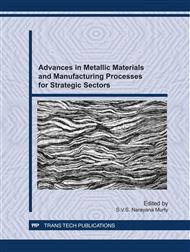p.471
p.477
p.483
p.489
p.495
p.500
p.506
p.511
p.516
Correlation of Mechanical Properties with Ferrite Number in 0.07C-16Cr-6Ni Stainless Steel
Abstract:
In the present work, the effect of varying subzero treatment temperature on ferrite number and consequent changes in the room temperature mechanical properties of a 0.07C-16Cr-6Ni stainless steel were investigated. In order to study the changes, different subzero treatments were conducted in the range of-10°C to-70°C. The heat treated specimens were characterized for ferrite number, hardness measurements and tensile properties. The results showed a significant increase in the ferrite number with sub-zero treatment and maximum increment was observed in the specimens subjected to-70°C treatment. Both yield strength and UTS follow linear relationships with ferrite number. The increase in yield strength with ferrite number was significant. However, the change in UTS with ferrite number was marginal because of the formation of strain-induced martensite during tensile testing. Hardness could directly be correlated with UTS for higher ferrite numbers (more than 53) only.
Info:
Periodical:
Pages:
495-499
Citation:
Online since:
January 2012
Authors:
Price:
Сopyright:
© 2012 Trans Tech Publications Ltd. All Rights Reserved
Share:
Citation:


